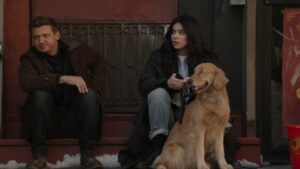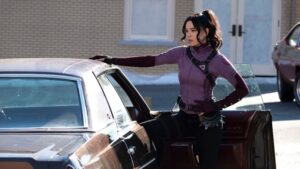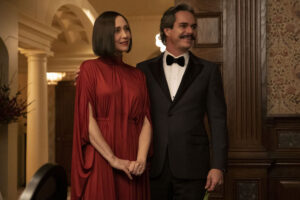SPOILERS FOR THE WHEEL OF TIME EPISODE THREE AHEAD!
It brings me great joy to report that The Wheel Of Time‘s third and fourth episodes, two of its best, were both helmed by director Wayne Che Yip. His resume is extensive, but it’s his work for Amazon Prime Studios that’s of pertinent interest to me. In recent years, he’s become one the streaming service’s go-to directors, having contributed to some of their biggest series’, including The Wheel Of Time, Hunters, and, yes, The Lord Of The Rings. I’m sorry that it’s always on the back of my mind, but if The Wheel Of Time is any indication, then the four episodes of Lord Of The Rings that Yip directed will be extraordinary.

In just two episodes of The Wheel Of Time, Yip broadens the scope of the entire series to include a spiritual or metaphysical dimension. Just as the extensive mythology of Tolkien’s Middle-earth was created not as a supplement to his published writings but as the backbone of his entire legendarium, Robert Jordan’s fantasy world (which I guess now is a good time to point out is technically just our world in another “Turning of the Wheel”) and all the stories that take place therein are built on a staggeringly vast and intricate cosmology partially inspired by Hindu and Buddhist theology.
And although The Wheel Of Time wades confidently into the deeper end of that pool, Yip uses purposeful direction and cinematography to weave Jordan’s themes of repetition, rebirth, and the permanence of human nature into the fabric of Amazon’s series so that any information you don’t get in the dialogue you’re still absorbing through recurring motifs and subtle details. This is a show that I know will stand up on a rewatch, as fans scour every episode for clues they missed the first time around.
That being said, it’s also clear that The Wheel Of Time has no intention of upholding the rigid binary systems around which Jordan’s cosmology is structured. Dualism is another prominent aspect of his novels, from the conflict between good and evil that spans the entire Wheel Of Time series, to the rift between men and women in Jordan’s world, which itself is derived from another clear-cut divide between saidin and saidar, the masculine and feminine halves of the One Power that permeates the cosmos and fuels the Wheel. To “channel”, i.e. use magic, men always tap into saidin, women always into saidar.
For the 1990’s, that seemed really progressive. But our understanding of all these subjects is constantly evolving, and Amazon’s Wheel Of Time reflects that by blurring the lines between the broad concepts that Jordan positioned as clear opposites in his books. The series depicts a world where gender and sexuality are more fluid, to the point where even the prophesied Dragon Reborn, who in Jordan’s books is always a man regardless of whatever else changes in his appearance, personality, and the circumstances of his birth and upbringing, is not locked down to being male or female.
And in keeping with Jordan’s own deconstructions of fantasy tropes like the chosen one, the series plants that persistent seed of doubt in our heads that this Dragon Reborn, whoever they are, will actually be able to fix the world – assuming they don’t just tear it apart in a mad rage, as everyone in-universe agrees is just as likely. In episode three, we meet our very first Darkfriend, a barmaid named Dana (Izuka Hoyle) who just wants the Dragon to break the Wheel of Time and let her and all of humanity escape from an endless cycle of pain and suffering. Until she attempts an abduction, her only crime is demanding better from the world.
But a well-timed knife throw from the gleeman Thom Merrilin (Alexandre Willaume) puts an end to all her dreams of escaping the mining town of Breen’s Spring and being uplifted to a place alongside the Dark One for her accomplishments. The other characters are forced to leave her body crumpled in an alleyway, while Yip’s framing of the moment forces us to seriously contemplate what is right and what is wrong, who gets to draw the line between the two and where, and how we enforce that often arbitrary distinction.
The Wheel Of Time poses these same questions over and over, just as the titular Wheel weaves endless variations of the same people and events out into the tapestry of human history, over and over. That the Wheel is sentient to some degree, and weaves into existence whatever it feels is needed at any particular moment to preserve the overall integrity of the pattern, is taken for granted the world over. As far as I remember (and to be fair, I haven’t read the books recently), nobody except the Dark One wants to break the Wheel, and even that’s just to fulfill an archetypal mission of chaos and cosmic destruction.
Here, it feels a bit more nuanced than that, which I appreciate. We don’t really know anything about the show’s version of the Dark One yet (apart from that vague title), but as evidenced by Dana, the Darkfriends at least seem to have opinions of their own on whether the Wheel is a good or a bad thing. Even the prevalent theory that Perrin Aybara (Marcus Rutherford)’s wife was a Darkfriend before she died in the first episode indicates that in Amazon’s adaptation, the Darkfriends aren’t just randomized vices in human shells. They’re humans, and their motives are understandable, if not sympathetic.
But The Wheel Of Time presents an alternative to their ideology that, while not without flaws of its own, is aimed at freeing humanity from the violent cycle in which they’ve been trapped for eons. In this episode, Perrin and Egwene al’Vere (Madeleine Madden) run into a band of the nomadic people known as the Tuatha’an. Heavily inspired by the Irish Travellers, and in the Amazon series also by the Amish, the Tuatha’an don’t believe in breaking the Wheel by force. Their “Way of the Leaf” preaches that nonviolence begets nonviolence just as the opposite is also true.
Although the Way of the Leaf is focused on more heavily throughout episode four, I’ll talk about it in this review because, well, I’m behind on reviews anyway and the first five episodes are out at this point, but also because it makes such a fitting counterbalance to the Darkfriend philosophy represented by Dana in episode three. The Tuatha’an aren’t scared by the Wheel’s endless turnings, because they don’t regard themselves as trapped in it. Instead, they see it as sobering that if they work harder to make the world a better place in the lives they have now, then the world into which they’re reborn will be better because of it.
Because most of this is explained through a very touching monologue in episode four, however, it doesn’t excuse the fact that in episode three itself the Tuatha’an feel like a detour. Egwene, who for the first two episodes was almost by default the series’ lead, is reduced to a supporting character in the series’ third-most important subplot as she and Perrin walk around the Tuatha’an camp looking baffled by their surroundings. Even given the state of their world, I find it hard to believe that pacifists are really the most shocking thing they’ve ever seen when they literally just escaped from a city that wanted to eat them.

With Rosamund Pike’s Moiraine Damodred unconscious throughout most of the episode courtesy of an injury sustained in episode one that conveniently waited until Shadar Logoth to knock out the powerful Aes Sedai, the burden falls on Zoë Robins to carry the series’ primary subplot. And after being given only a handful of scenes in episode one, Robins’ Nynaeve al’Meara is revved-up and ready to go when she returns in full force to let you know, dear viewer, that she’s not a damn side character, and it’s gonna take more than a Trolloc to stop her.
From her opening scene in this episode, in which the introverted village Wisdom brings down the aforementioned Trolloc on her own turf, to the revelation that she somehow tracked Lan Mandragoran (Daniel Henney) from Emond’s Field to Shadar Logoth, Nynaeve is clearly formidable and impressive on many levels. But she’s not invulnerable, and she’s not above feeling frightened just because she outwitted one Trolloc. She’s scared for herself, and you genuinely get the sense that she’s terrified for Egwene and for the others through Robins’ raw line-delivery and physical performance.
Reading the early books of Jordan’s series, I didn’t feel anywhere near as strong a connection between Nynaeve and the other characters (least of all Lan, with whom she’s suddenly in love one day; the premise of most of Jordan’s romances). Granted, it’s been a minute since I’ve read the books, but Nynaeve’s decision to join the group there is framed as something of a reluctant obligation, if I remember correctly. And from that point on, she falls into a semi-comedic babysitter role; constantly distracted yet self-righteous, controlling yet completely ineffective at monitoring the others.
Robins’ Nynaeve is still stubborn and impatient and endearingly irritable, but we get to see a more fiercely caring side of her in her interactions with the injured Moiraine, and even with Lan; not because she cares deeply about him (yet), but because he stands in the way of her finding her friends again. When forced to work together for their mutual benefit, Nynaeve and Lan quickly develop real tension and chemistry that foreshadows their eventual romantic relationship in the books.
Speaking of romantic chemistry, I can’t not mention that the first barely audible word out of Moiraine’s lips when she wakes from sleep near the end of the episode is the name “Siuan”, a nod to one of my favorite characters in the books, Siuan Sanche. Like many of the women in the Aes Sedai order, Moiraine and Siuan were canonically lovers in their youth, but Jordan’s books explain this away as a consequence of there not being any men around. In other words, it’s queer enough for straight men to fetishize their relationship, but not queer to the exclusion of straight men. That’s the kind of queer representation that fills The Wheel Of Time.
But in the Amazon series, I’m hopeful that Moiraine and Siuan’s relationship will just be queer, without any caveats or asterisks. Episode three indicates that the world of The Wheel Of Time is accepting of queer relationships, with Dana misreading Rand al’Thor (Josha Stradowski) and Mat Cauthon (Barney Harris)’s relationship as more than platonic, only for Rand to tell her that if he wanted a man, he could do much better than Mat. Harsh, but true.
It’s not that I don’t like Mat (although I’ll admit that Harris’ performance hasn’t blown me away, and the news of his recasting for season two doesn’t fill me with sorrow as it does others), but I still feel that we didn’t get enough time to know the real Mat in the first two episodes before getting stuck with the mean and temperamental post-Shadar Logoth Mat. His best scenes involve him bouncing off of Thom Merrilin, who is simultaneously sympathetic to Mat’s plight and unprepared to waste precious time humoring his nonsense.
Perhaps the most obvious example of a character whose been changed in the adaptation process, Amazon’s Thom is a far cry from Jordan’s version of the traveling gleeman with his harp and gaudy, brightly-colored patchwork cloak. For one thing, he no longer carries a harp, and his patches are more subdued – a mere flash of color in the folds of his coat, quickly hidden away. These and other physical changes to the character may have their critics (even I was taken aback by the lack of mustaches), but Amazon’s Thom isn’t meant to be the stereotypical, instantly recognizable bard of Jordan’s books.
The craggy, gravelly-voiced Thom of Amazon’s Wheel Of Time, who stuns a crowd speechless with songs of grief and madness accompanied by plaintive guitar-strumming, owes more to modern folk-singers and rock-stars than to medieval bards. But that makes total sense for a character whose responsibility as a gleeman is to preserve ancient oral histories and traditions, because as I pointed out above, The Wheel Of Time takes place in what is implied to be our far-distant future. Cars and computers didn’t survive the Breaking of the World, but someone in the future is looking out for Led Zeppelin, and I think that’s beautiful.
Thom takes that responsibility seriously, too. He may not be as garrulous as his counterpart in the books, but when he does share a story or a monologue or even just a few words of advice, it’s always to pass along some piece of profound wisdom enriched by personal experience. When Thom finds Mat attempting to rob a corpse so he can afford to get back home, that’s the moment where we expect him to step in and gently dissuade the younger man. But Thom stands aside, not because he approves of Mat’s actions, but because he knows what desperation is and you feel in Willaume’s performance that he knows it intimately.
All he asks of Mat is that he have the decency to bury the dead after he’s finished. And on my first time watching the episode, I misinterpreted Thom’s words as a subtle jab at Mat, but by the tone of Willaume’s voice you can tell he means it sincerely, not as an insult or some kind of burn, but as a plea to Mat to never lose his humanity even when dark times force him to do terrible things. Because sometimes the wrong way is the only way, as we see when Thom himself kills Dana to save Rand and Mat.

And in true Wheel Of Time fashion, that brings us full-circle to the question of what is right and what is wrong, a question to which there is no easy over-arching answer. The best we can usually do is find a balance between doing what’s right by others and what’s best for our own wellbeing, but the capacity for good and bad, even heroism and villainy, exists in all of us. And as long as Amazon’s The Wheel Of Time continues to play in that inherently gray area that is the human heart and soul, I believe the series will continue to feel faithful to Jordan’s spirit of exploration.
Episode Rating: 8.5/10








